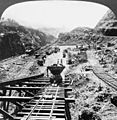Railway track facts for kids

A railway track or railway line is like a special road made for trains. It's built with two long, parallel (side-by-side) pieces of steel. Trains use these tracks to carry people and goods from one place to another. In the USA, people often call them "railroads" instead of "railways." Sometimes, a railway line has more than one set of tracks. For example, trains might use one track to go east and another to go west.
Contents
How Railway Tracks Are Built
Railway tracks are made up of several important parts that work together. These parts help the tracks stay strong and keep trains running smoothly.
Rails and Sleepers
The long steel pieces that trains run on are called rails. These rails are held in place by cross-pieces called sleepers (or ties in America). Sleepers are placed regularly under the rails. They help spread out the heavy weight of the train wheels onto the ground below. Sleepers also make sure the rails stay the correct distance apart. This distance is called the gauge. Sleepers are usually made from strong wood or concrete.
Ballast and Foundation
Below the sleepers, you'll often see a layer of small, broken rocks. This layer is called ballast. The ballast helps to hold the railway tracks firmly in place. It also allows water to drain away easily, which keeps the tracks stable. Sometimes, special machines called ballast tampers are used to pack the rocks tightly. This makes the tracks even stronger and more stable.
How Wheels Stay on Track
The top surfaces of the rails are slightly angled inwards. The rims of the train wheels are also angled in the same way. This special design helps to guide the train along the track. Each train wheel also has a part called a flange. This is a raised edge that sticks out from one side of the wheel. The flange prevents the train from "derailing," which means coming off the track. It's especially helpful for guiding the train safely around sharp curves.
Images for kids
-
Ladder track at Shinagawa Station, Tokyo, Japan
-
A pull-apart on the Long Island Rail Road Babylon Branch being repaired by using flaming rope to expand the rail back to a point where it can be joined together
-
Flange oilers lubricate wheel flanges to reduce rail wear in tight curves, Middelburg, Mpumalanga, South Africa
-
Intercity-Express Track, Germany
-
Track of Singapore LRT
-
A track renewal train in Pennsylvania
See also
 In Spanish: Vía férrea para niños
In Spanish: Vía férrea para niños



















